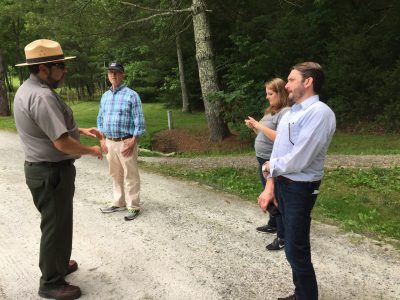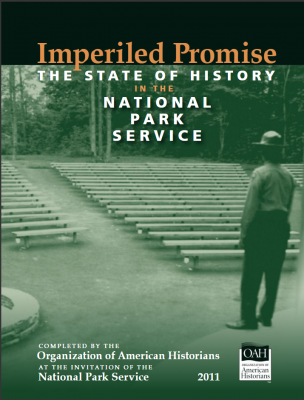Remembering Aidan Smith
07 May 2018 – Anne Mitchell Whisnant

Aidan Smith (far right) at the launch of the Carl Sandburg Home National Historic Site project, 2016. Image courtesy Anne Mitchell Whisnant
Our encounter in the hotel lobby on the final day of the Las Vegas NCPH conference was brief—one of those “darn, we missed each other!” moments of a busy event filled with valued but too-rarely seen colleagues. Pulling his suitcase, Aidan was heading for the airport after two weeks of conferencing—probably as exhausted as he looked. I was on my way to lunch. Chatting for five minutes, we focused on business: a project payment not yet received, reassurance that “there is no problem,” a pledge to check on it when he got home. “Send an email to remind me,” he said. “We’ll talk soon!,” we promised. “Bye!” And he rushed away.
By the time I sent the reminder on Monday, he was already gone, dead in his sleep at age 37.
I met Aidan Smith via email in July of 2011 when he took the reins of the OAH’s public history program from Sue Ferentinos. With this transition, he became the project manager for one of the highest-profile projects ever conducted under the ongoing OAH-National Park Service collaboration: the in-process “state of history in the National Park Service” study I was then chairing.
We were both surprised that we had (apparently) not crossed paths at UNC-Chapel Hill, where I worked for several years while he did graduate work in the history department. Never mind, though, we were soon in nearly daily contact.
When Aidan arrived, the “state of history” study and I were in a crisis as our submission deadline of August 2011 loomed. As project chair, I bore great responsibility for seeing that the work was completed, but of the four team members, I was probably the least well-situated to be writing a book-length report. As a twelve-month university administrative employee, I was the only one not in a faculty post or semi-retired. I was also the only one with active parenting duties. Two weeks of vacation I had had available in June of 2011 had been taken up by a (wonderful, but terribly timed) trip to Italy that my parents had given me and my 11-year old son.
To make matters worse, our team had been struggling to find our voice and write as a group. As of May, we had produced eighteen separate, disconnected documents that we referred loosely to as our “draft.” At that point, I had decided to assemble the pieces into a single Google Doc on which we would all thereafter work. I was making progress, but it was increasingly clear to me that we would never submit by the August deadline. As I biked to work many days, I felt a sensation of hands around my neck.
My second email to Aidan explained our dilemma and my panic. Could he help us navigate a request to NPS for another extension? He jumped on the task, and before long, we had a reprieve: a December 31 deadline, granted with a stern admonishment that no more time would be given.
Aidan and I then began a frantic tag-team dash to the finish. Over 1,000 emails between us document our partnership. We spoke by phone regularly as well, and his steadiness and reliability, empathetic and reflective listening, perceptive insights, lack of pretense, and easy way with conversation quickly built a level of trust that made our working relationship feel like (and become) a friendship.
As summer waned, I rose at 5:30 to write before work. In fall, team colleague Marla Miller and I held a writing retreat to hammer out remaining sections. The rest of the team weighed in with additions, and we finalized our draft and circulated it for review from NPS colleagues. Meanwhile, Aidan helped us get a handle on the remaining project budget, arranged to pay graduate assistants for some final data compilation, gathered illustrations, engaged a copy editor and graphic designer, and worked with me to plan for report launch in the spring of 2012 at the OAH/NCPH annual meeting. Owing significantly to his dogged attention to these many details, Imperiled Promise: The State of History in the National Park Service rolled off the press with a couple of weeks to spare.
Aidan and I remained in close contact through 2014, as we coordinated a (not-planned-for-in-the-original-scope) conversation tour to call attention to Imperiled Promise‘s recommendations. He helped me procure funds from NPS for more print copies, travel, and conference sessions at the George Wright Society, NCPH, and the National Association for Interpretation. He also orchestrated a coordinated letter from OAH, NCPH, AASLH, and the AHA to the NPS director urging adoption of key recommendations.
Due in large part to Aidan’s sustained energy and interest, Imperiled Promise has been broadly influential across the NPS and in the public history community. Although my co-authors and I get byline credit for the work, there is no doubt that Aidan Smith was a critical fifth member of the Imperiled Promise team. I will always be grateful to him for helping me turn what I feared might become a professional disaster into one of my proudest accomplishments.

“Imperiled Promise: The State Of History in the National Park Service.” Image courtesy OAH
After Imperiled Promise, Aidan and I were not in touch as often, except for at the NCPH or OAH meetings. Since he was not active on social media and lived far away, I never learned of his love of cooking and cats or met his partner. But in 2016-17, he engaged my husband David Whisnant and me in a new research project for North Carolina’s Carl Sandburg Home National Historic Site. This project, kicked off together at a site meeting in June of 2017, has provided financial support as I have navigated nine months without full-time employment. At Aidan’s death, our first two draft chapters sat on his desk, and we had looked forward to receiving his comments and guidance on next steps.
With his deep experience working with both NPS and many non-agency historians, Aidan was a crucial intermediary whose work served the country, the National Park Service, and the cause of high quality, transformative public history. I will feel his loss intensely and invite others who have worked with him on NPS projects to share photographs or memories below.
~Anne Mitchell Whisnant is a professional historian whose teaching, research, speaking, consulting, and writing focus on public history, digital and geospatial history, and the history of the U.S. National Parks. She is a public historian in private practice, working with her husband David Whisnant as co-principal of the public history consulting firm Primary Source History Services, based in Chapel Hill, NC.




Thanks for this lovely tribute, Anne. I worked with Aidan on two OAH scholar visits at national parks and was always so impressed by how affable and unflappable he was. This is such a sad loss for the public history community.
Thank you for sharing Anne. He is intensely missed.